
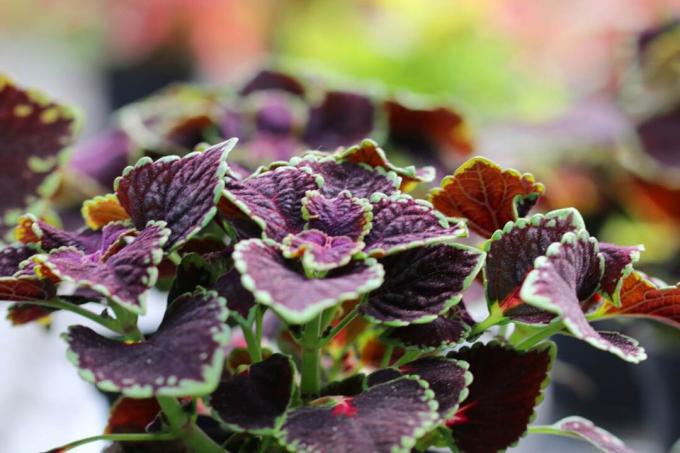
Table of contents
- Characteristics
- Location
- temperature
- substrate
- Colored nettle in a pot
- Colored nettle in the garden / balcony box
- plant neighbors
- Pour
- Fertilize
- Cut
- blossoms
- Overwintering & repotting
- multiply
- seed
- cuttings
- method water glass
- method substrate
- Pests & Toxicity
The colored nettle, also called red nettle, inspires with its single-colored to motley leaves. Depending on the variety, they can be red, yellow, green, purple or brown.
Characteristics
- botanical names: Coleus blumei, Solenostemon scutellarioides, Plectranthus scutellarioides
- Synonyms: Solenostemon scutellarioides, Plectranthus scutellarioides
- Plant Family: Lamiaceae (Lamiaceae)
- Growth: upright, bushy
- Growth height: 30 to 60 centimeters
- Growth width: 15 to 40 centimeters
- Leaf: unicolored to variegated, in a wide variety of colors and patterns
- Leaf shape: ovate, acuminate, serrated
- Flowers: inconspicuous, lip-shaped panicles from June to July
- Use: ornamental foliage plant
Location
Basically, the colored nettle, also called stained leaf, tolerates sunny to shady locations. However, if the nettle is (too) dark, the leaves lose their bright color and turn green. Therefore, for Coleus blumei you should have one
- sunny until
- go off the sun
choose location. Since the leaves burn easily in strong sunlight at midday, you should shade the red nettle in sunny places.
temperature
Colored nettles are extremely sensitive to cold. The lower temperature limit is between 12 and 14 degrees Celsius. If the temperatures fall below this, the variegated leaf sheds its leaves and dies. The ideal temperature for the nettle is 18 degrees Celsius all year round. That is why it is usually kept as a houseplant. However, the ornamental leaf plant can spend the summer outdoors on the balcony or terrace. The outdoor season begins when temperatures remain consistently above plus 15 degrees Celsius and ends when they settle at 15 degrees Celsius.
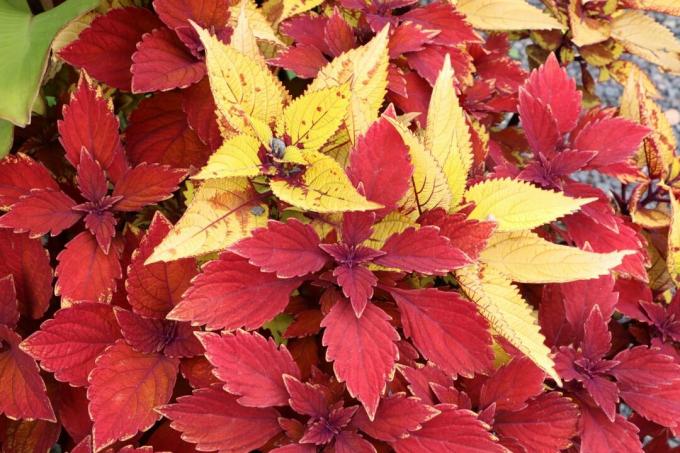
Nevertheless, planting out in the garden is possible. Due to its sensitivity to cold, the variegated leaf is only cultivated once a year when planted out, which also applies to balcony boxes. So that you don't have to do without the decorative leaf plants in the coming year, you should multiply the nettle in summer.
substrate
For bushy and compact growth, the colored nettle needs a substrate that provides it with a good supply of water and nutrients. Regardless of whether you cultivate the stained leaf in a pot or planted out, the soil should have the following properties:
- humorous
- nutritious
- good water retention
- well drained
- pH value: neutral to slightly acidic
Colored nettle in a pot
For the tub / pot culture, you should put the red nettle in a larger planter after purchase so that the variegated leaf can develop well. Repotting is possible all year round. However, it is ideal if you carry out the measure in the spring. In order for your coleus to develop well, proceed as follows:
- Choose a planter with drainage holes
- Lay out a drainage layer of potsherds and/or gravel on the ground
- put a layer of substrate (regular compost-based potting soil) on top
- Insert colored sheet
- Embedding depth: same as when purchased
- mix some sand or grit into the substrate before filling
- water well
Colored nettle in the garden / balcony box
You should not plant any colored nettles in the bed or balcony box until mid-May at the earliest, after the ice saints. Since the plants are extremely sensitive to cold, you should take the temperature in your area into account.

Proceed as follows:
- Dig a planting hole twice the size of the bale
- Planting depth: same as when purchased
- Planting distance: 20 to 30 centimeters (half the maximum growth height)
- Create a drainage layer at the bottom of the planting hole (a few centimeters of sand or grit)
- put a layer of earth on top
- Use colored nettles
- fill with soil and some compost
- Lightly press
- wash well with water
plant neighbors
Colored nettles come into their own as solitaires as well as in groups. How colorful you make the group of plants depends on your taste. For soloists, it looks pretty if you match the color of the planter to the leaves. For example, the following are suitable for combining with other plants:
- Busy Lizzies
- fuchsias
- begonias
- evergreen grasses, ferns, ivy
Pour
Coleus blumei needs a lot of water in summer. The red nettle cannot cope with drought. Nevertheless, you shouldn't mean it too well, because the ornamental leaf plants don't tolerate waterlogging either. Water your coleus
- regularly and with
- with lime-free water.
You should remove excess water from the saucer after a few minutes. You can also refresh the leaves in the evening by spraying them with lime-free water.
A notice:
If stinging nettles suffer from drought, even for a short time, they shed their leaves.
Fertilize
Potted plants welcome extra nutrients during the growing season if they have not been freshly repotted. A conventional liquid fertilizer for green plants or flowering plants is completely sufficient. Ideally, fertilize from April to August
- a houseplant every two weeks
- Colored nettles on the balcony weekly
Tip:
With a long-term fertilizer in the form of fertilizer sticks, you should only administer half the dose to the stained leaf.
Plants planted out in the garden or window box do not need any additional nutrients if you mixed compost or horn shavings into the soil when planting them out.
Cut
You can ensure bushy growth if you prune young colored nettles from the start. For older plants, you should
- Thin out older and bare shoots regularly and
- Prune them back more as needed (just over a pair of leaves).
Tip:
By regularly breaking out the shoot tips, you encourage the variegated leaf to grow bushy.
blossoms
Since the leaves are the real star of this nettle, many hobby gardeners do without the inconspicuous flowers. They are already snapped off in the bud stage so that their development does not cost the variegated leaf unnecessary energy, which can be at the expense of leaf colouring.
Overwintering & repotting
If the colored nettles have spent the summer outdoors, they hibernate
- bright
- at a temperature between 15 and 20 degrees Celsius
Year-round indoor plants can remain in their usual location. All plants need less water in winter.
You should repot young nettles every two months. Adult plants are placed in a new pot as soon as the old pot has rooted through.
multiply
The red nettle can be propagated with cuttings or seeds.
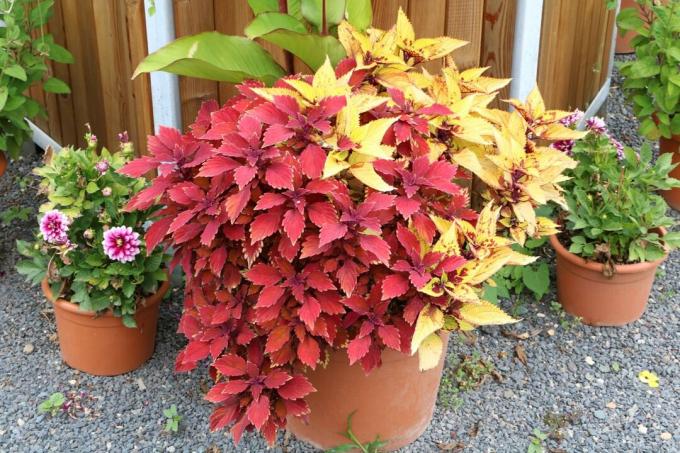
seed
Propagating your own colored nettles with seeds is not recommended. On the one hand, the flower buds must not be pinched off, on the other hand, the plants have to spend the summer outdoors so that fertilization can take place. In addition, it is not possible to calculate what color the leaves of the new nettles will be. In addition, this type of propagation is quite a lengthy affair.
cuttings
Propagation with cuttings is easy. The ideal time is in summer or autumn. When selecting the shoots, it is best to use the following criteria:
- healthy, strong
- without flower bud
- not too fresh, but a little more robust
- at least two to of the pairs of leaves with a particularly characteristic coloring / markings
- Length to stick: about ten centimeters
For rooting, the top cuttings are either placed in a glass with water or directly in the substrate. The following applies to both methods: If the propagation takes place in summer, the young plants can spend the remaining time outdoors. For autumn propagation, place the plants on a bright window sill. For them, the outdoor season doesn't start until next year.
method water glass
- Fill a suitable glass with lukewarm water
- remove the lower pair of leaves from the cuttings
- Leaves must not come into contact with the water (danger of rotting)
- place in a bright place (out of direct sunlight).
- Change water every few days
After one to a maximum of two weeks, the cutting should have formed roots. When these have reached a length of about five centimetres, you can place them in a pot with standard soil mixed with a little sand.
method substrate
- prepare a small pot with standard or potting soil
- Stick the cutting two to three centimeters deep into the moist substrate
- lower pair of leaves removed
- put in a bright place without direct sun
- Keep substrate slightly moist
Tip:
You can tell whether the propagation was successful by the fact that the cuttings form new leaves.
Pests & Toxicity
In dry and warm air, an infestation with spider mites occasionally occurs. Find the typical webs on the stinging nettle, spray the stained leaf with water and/or cut off heavily infested shoots.
The colored nettle is slightly poisonous and not suitable for consumption. The toxicity for dogs and cats is discussed differently. The red nettle can be deadly for small rodents and ornamental birds.
 garden editorial
garden editorial I write about everything that interests me in my garden.
Learn more about houseplants
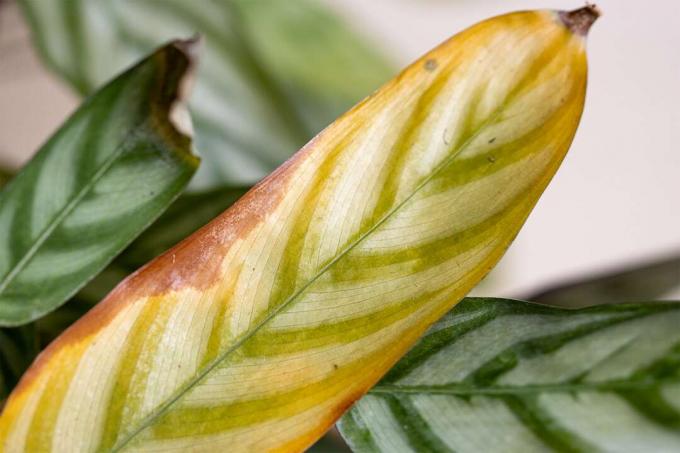
Calathea has yellow leaves: how to save?
When a Coriander (Calathea) gets yellow leaves, the cause is usually a lack of care. In order to save them from dying, a number of countermeasures must be taken, which are described in detail here.

Room bamboo: 13 tips for care
The room bamboo impresses with its compact growth habit and is a densely grown houseplant. The ten most important tips for caring for the sweet grass are compiled for you here.
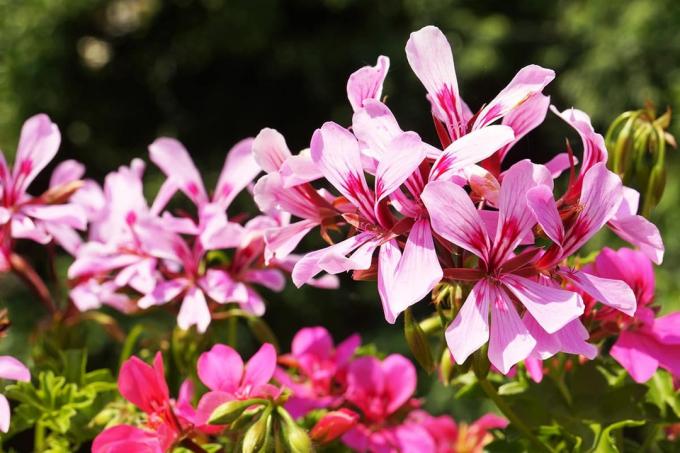
Scented houseplants: 25 scented plants for the home
An apartment without indoor plants is hardly conceivable. Scented plants in particular have a very special effect. Not only are they decorative, they can lighten the mood and rival any artificial home fragrance.

Lucky chestnut, Pachira aquatica: care from A to Z
The care of the lucky chestnut does not require any special expertise. However, if you know the way of life of this ornamental plant, you can better adapt site conditions and care measures to your needs. The plant can be easily propagated if a plant already exists.

Rubber tree: 13 care tips for Ficus elastica
The rubber tree is one of the most popular indoor plants. It is available in different varieties, easy to care for and stands out for its large leaves, which are colored in intense shades of green. Within a few years, it grows into a state small tree without much effort.

Ray Aralia, Schefflera: care from A to Z
Schefflera arboricola delights hobby gardeners with lush growth in suitable locations. It has hardly any special requirements and proves to be extremely easy to care for. Beginners will have a lot of fun with this plant because it forgives minor care mistakes and is adaptable.
